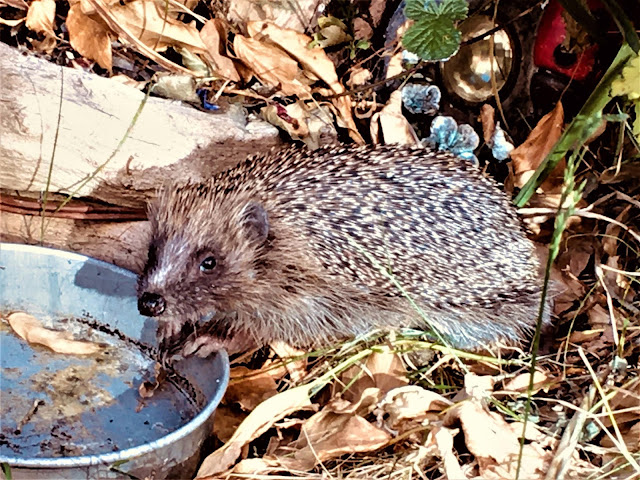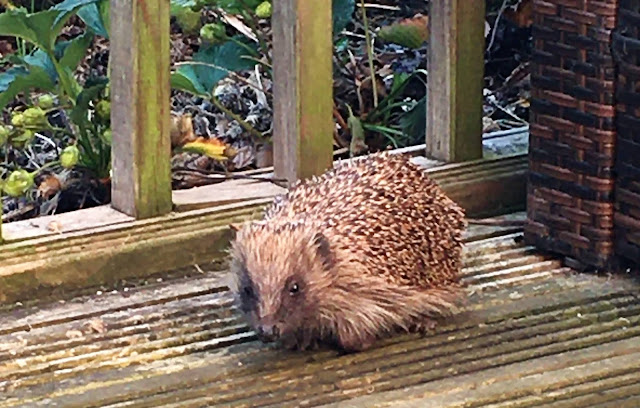So cute, loveable, prickly and truly iconic. With a brown pointed
furry face, small black eyes and big nose and covered in several
thousand speckled brown and cream spines. Really – who has not heard
of a hedgehog and what they look like - even if you have not seen one
in real life.
The challenging coronavirus period of 2020 has been made much more bearable in our house by the visit of wild hedgehogs. Seeing them nest, drink,
feed and play in our and surrounding gardens have really made us enjoy
their company on lockdown evenings.
Our Coronavirus Summer of Hedgehog Love
Sadly, although hedgehogs are one of the UK’s best-loved mammals The
Mammal Society has put the UK’s native European Hedgehog, which inspired
the Beatrix Potter’s character Mrs Tiggy-Winkle,
on the ‘at risk’ list. Britain’s hedgehog population may have decreased by as much as 73% in
the last twenty years with less than a million remaining.
Roaming hedgehogs
One of my earliest memories is of my dad finding a hedgehog in our
garage late one evening. We lived in the suburbs of Coventry then. We
fed it but, in the morning, it was gone. And I don’t remember it
returning. A couple of years ago we discovered a hedgehog in our garden,
followed by intermittent sightings in the neighbourhood. Then this year
we have been so lucky to have two hoglets born at the end of our
garden.
Hedgehogs are nocturnal, travelling around one to two kilometres per
night, often using the same daytime nest for just a few days before
moving on. There are about one million West European hedgehogs living in
the UK.
During the couple of months that the hedgehogs visited our garden during lockdown I discovered:
- They gather up leaves and grass with their mouths and are very efficient at building nests from natural garden debris.
- They have long skinny back legs – until I’d seen one up close I hadn’t realised how long and skinny their legs were.
- They are pretty fast at moving – much quicker than I’d imagined but not quick enough to get out of the way of moving vehicles on roads.
- They have fun – the two hoglets thoroughly explored the garden, behind every nook and cranny and then climbed on top of their nest. They also bumped into each other playing and each one immediately rolled themselves up into a tight ball.
- They can climb – easily getting onto the raised beds to access the fence holes.
- They can make themselves nearly flat to squeeze under fences.
- They don’t like strawberries – they walked through my strawberry plants every evening while totally ignoring the red fruit.
- They are not scared of humans – one day the hedgehog managed to signal to me the water bowl was empty so I filled it up.
Hedgehog habitat
Hedgehogs are found across the UK and can live in a variety of habitats
including woodland, farmland, parks and gardens.
We live in a city; our garden is only approximately 8m2but that is
plenty big enough for a family of hedgehogs to spend spring and summer.
According to Oak & Furrows Wildlife Rescue Centre “very tidy gardens are NOT friendly places for hedgehogs.”.
Although we have some decking, a kitchen garden, and a small lawned
area, there are two borders that we have tried to keep wilder to attract
wildlife. They are left un-weeded, wilder, leaves and grass cuttings are
left on the ground and we have pile of compost for the decomposing and
discarded off-cuts from the garden at the intersection of the two
borders. This hopefully complements the daisies and dandelions in the
lawn and the berries and vegetables growing in the min-allotment without
chemicals and pesticides. A small pot of water is there for the bees and
seeds to feed the birds, and there is easy access to neighbouring
gardens. This wilder area has also attracted hedgehogs. We don’t have a
hedge but the area of they chose to nest is protected and sheltered by a
wall.
We didn't build a hedgehog house or feeding station but instead created an environment where hopefully hedgehogs can thrive on their own.
Encourage a hedgehog to thrive
Although they are killed on the roads and killed by creatures such as foxes, ferrets, weasels and hawks and owls, the biggest threat to hedgehogs is thought to be habitat loss, the removal of hedgerows and the use of chemicals in gardens.
To help hedgehogs thrive try …
Leaving fresh water out for them to drink. Milk also makes
hedgehogs ill as they are lactose intolerant, The hedgehog’s natural
diet mainly consists of ground beetles, caterpillars, worms and
slugs.
Create a log pile create an insect factory and wildlife haven
providing year-round food supply as well as a place to stay.
Build a compost heap attract hedgehogs as a nest but also as a
place full of insects (food).
Leaves can be used for bedding material
Put holes in fences allow hedgehogs to roam freely getting
everything they need from a network of gardens.
Garden ponds with a gently sloping edge – a year-round water
supply, insects, amphibians and hedgehogs can swim.
A hedgehog life
According to
The British Hedgehog Preservation Society hedgehogs:
· Age – can live up to 10 years but on average of they survive the
nest and first hibernation on average live for 3-5 years
· Mating season is May (a hedgehog summer of love was forecast for
2020 following the COVID-19 lockdown after there was some evidence to
suggest the lockdown provided a safer environment for hedgehogs. A study
by Nottingham Trent University suggested the number of hedgehogs killed
on the road has halved during the lockdown.
· Family – live solitary lives except during mating season. A
female hedgehog is a Sow and raises her young alone, without the male
hedgehog, a Boar. The Sow forages and returns to feed her young while
they are too small to leave the nest.
· Baby hedgehogs – hoglets are born from May onwards in litters
2-6 in size. After three or four weeks the hoglets will join their
mother on her foraging trips, quickly learning what is good to eat.
Hoglets leave the nest at 5-6 weeks old (June/July) to wander off on
their own, to live solitary lives without encountering their parents or
siblings.
· Hibernation generally takes place between November and
March.
5 fun hedgehog facts
-
A group of hedgehogs is called an array however a rare sight as they are solitary creatures who usually come together only to mate.
-
Hedgehogs have poor eyesight and rely on their sound and smell
-
The name hedgehog comes from their love of garden hedges and the snuffles and grunts they make that sound like a pig
-
A hedgehog is one of only three mammals that truly hibernate in the UK – the other two are bats and dormice.
-
They are omnivores, eating whatever they can get into their mouths, including slugs, millipedes, earthworms, beetles, caterpillars and other insects.
Our hedgehogs now appear to have moved on this summer, but I really hope they will be back. I feel really privileged that a hedgehog chose to nest in our garden and raised two hoglets. They really are a joy to have in the garden. What wildlife is living in your garden?


























0 Comments